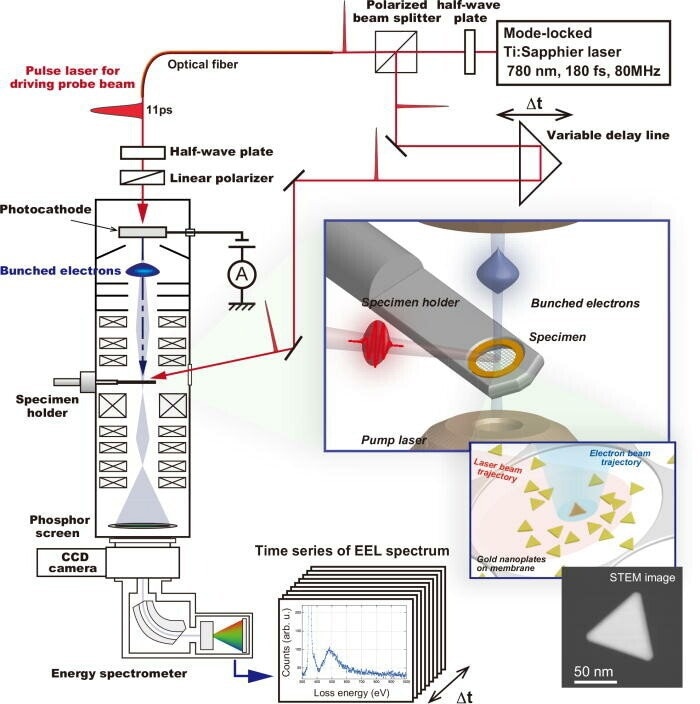A group of scientists from Nagoya University in Japan used a novel combination of technologies to investigate the principles of light–matter interaction in nanomaterials at the lowest and fastest levels.

Experimental setup for transient EELS in the TR-TEM and the pump-probe system. The insets show enlarged schematic illustrations of the specimen position and a scanning transmission electron microscope (STEM) image in the TR-TEM. Credit: Applied Physics Letters (2022). DOI: 10.1063/5.0108266
Nanomaterials, or materials with nanoscale dimensions ranging from 1 to 100 nanometers, are becoming increasingly essential in industry and daily life. Due to their extremely small size, they have unique features not seen in bulk materials. These features are also unique to the material's nature and environment.
To increase the number of nanomaterials that may be used efficiently, securely, and sustainably in goods and manufacturing processes, we need a greater comprehension of even the smallest events that take place on and inside nanoparticles.
Nanometrology, a branch of metrology, is used by researchers to quantify nanoparticles and is the measurement of length scales at the nanoscale. Researchers must evaluate events that take place in fractions of a second when particles are this tiny.
A phenomenon known as photoexcitation, for example, occurs in picoseconds, or one trillionth of a second. To evaluate these almost instantaneous events, specialized instruments are required.
A research team guided by Nagoya University faculty members, Associate Professor Makoto Kuwahara of the Institute of Materials and Systems for Sustainability (IMaSS), and Lira Mizuno, Rina Yokoi, and Hideo Morishita of the Graduate School of Engineering, explored whether such photoexcitation processes occurring on single nanoparticles could be studied.
Researchers collaborated with senior experts at Hitachi Hightech Ltd. to create an ultrafast electron microscope by fusing a general-purpose electron microscope with a semiconductor photocathode with a Nagoya University-invented “Negative Electron Affinity” surface. Events at the nanoscale can be watched using the resulting microscope developed by integrating these technologies. In Applied Physics Letters, the researchers reported the results of their study.
The team used chemically produced gold nanotriangles for the nanoparticles. Due to its noble nature, gold is an appropriate metal for such studies, indicating that it is stable in a variety of situations. The phenomenon known as “plasmon resonance” is manifested by the electrons in gold nanoparticles.
A gold nanoparticle that has undergone photoexcitation with a particular wavelength of light experiences oscillations or movement of its electrons, increasing the intensity of the light, and transforming the gold nanoparticle into a bright antenna. As a result, surface plasmons on gold are frequently utilized for sensing and are of significant importance in energy conversion.
The ultrafast laser in the novel custom-built ultrafast electron microscope can be used to photoexcite plasmons in gold nanoparticles while enabling researchers to see single gold nanoparticles. Using their novel technique, the researchers analyzed two separate plasmon events.
Researchers first noted the surface plasmons relaxing, which is a well-studied event. Their novel technique, however, enabled them to see changes in the plasmons inside the gold nanoparticles even though the light only touched the nanoparticles’ surface.
This is the first time that technology has shown the relaxing process of these plasmons inside gold nanoparticles, which has crucial implications for developing light-harvesting materials for energy conversion. By revealing ultrafast light-matter interactions, the newly proposed approach should aid in analyzing promising materials.
By understanding phenomena such as photoexcitation and relaxation processes and energy transport, we can improve photoresponsive properties and increase efficiency. In particular, it can be a powerful tool to capture individual time changes in small structural materials with spatial resolution (such as those that exceed sub-micrometers). This has been difficult to achieve with conventional analytical methods using pulsed lasers as probes.
Makoto Kuwahara, Associate Professor, Institute of Materials and Systems for Sustainability, Nagoya University
Kuwahara concludes, “We expect this achievement to enable the analysis of photoelectric and thermoelectric conversion materials and their applied devices that contribute to energy conservation. Our research should be useful for the development of light energy conversion, biosensors, and thermoelectric conversion devices.”
The study was funded by the Grant-in-Aid for Scientific Research, Basic Research (A) (21H04637), which started in FY2021.
Journal Reference:
Kuwahara, M., et al. (2022) Transient electron energy-loss spectroscopy of optically stimulated gold nanoparticles using picosecond pulsed electron beam. Applied Physics Letters. doi.org/10.1063/5.0108266.